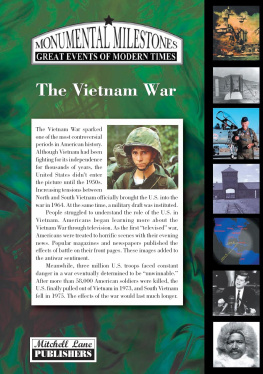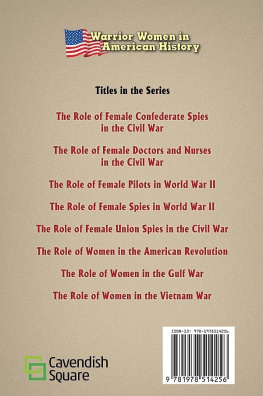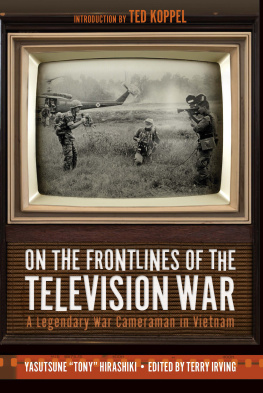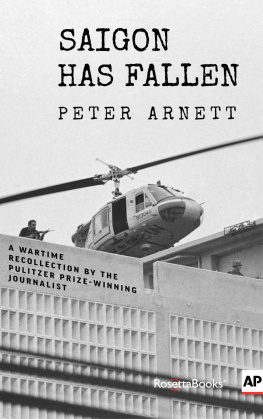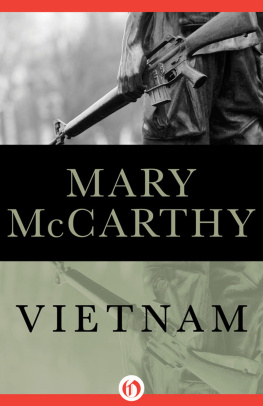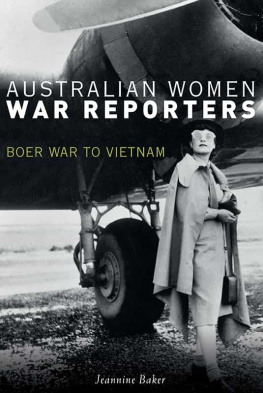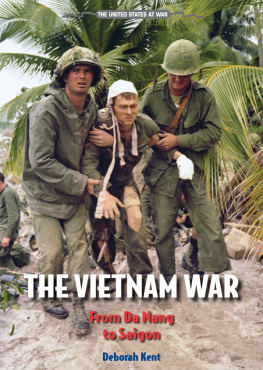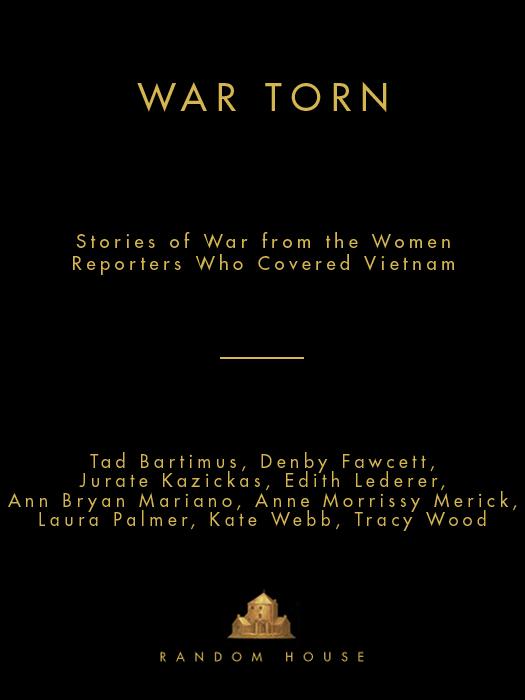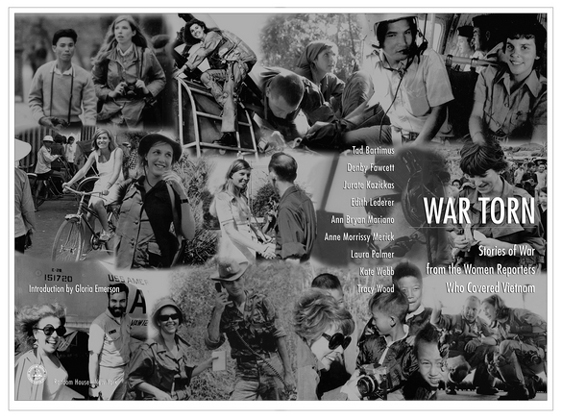Copyright 2002 by Denby Fawcett, Ann Bryan Mariano, Kate Webb, Anne Morrissy Merick, Jurate Kazickas, Edith Lederer, Tad Bartimus, Tracy Wood, Laura Palmer
Introduction copyright 2002 by Gloria Emerson
Map copyright 2002 by Anita Karl and Jim Kemp
All rights reserved under International and Pan-American Copyright Conventions. Published in the United States by Random House, Inc., New York, and simultaneously in Canada by Random House of Canada Limited, Toronto.
Random House and colophon are registered trademarks of Random House, Inc.
Library of Congress Cataloging-in-Publication Data
War torn: stories of war from the women reporters who covered Vietnam/Denby Fawcett [et al.]; introduction by Gloria Emerson.
p. cm.
eISBN: 978-1-58836-040-3
1. Vietnamese Conflict, 19611975Personal narratives, American. 2. Vietnamese Conflict, 19611975Journalists. 3. Women JournalistsUnited States. I. Fawcett, Denby.
DS559.5.W3677 2002 959.70430922dc21 2002069922
Title-page photo credits, top row: Horst Faas, Wide World Photos, personal collection of Jurate Kazickas, personal collection of Tad Bartimus; center row: The Honolulu Advertiser (Bob Jones), personal collection of Laura Palmer, personal collection of Tracy Wood, personal collection of Anne Morrissy Merick, UPI; bottom row: Neal Ulevich, ABC News, personal collection of Tad Bartimus, U.S. Air Force
Random House website address: www.atrandom.com
v3.1_r1
We dedicate this book to those who went and those who waited,
and to those who did not live long enough to tell their own stories.
A Note to the Reader
This book is about our experiences as women reporters covering the Vietnam War from 1966 until the fall of Saigon in 1975. Each of us has written a chapter about what we saw and felt in Indochinaour adventures, fears, excitement, and the difficulties and loneliness.
Vietnam was a unique war for all journalists, because there was no censorship. The U.S. military provided extraordinary access to combat operations. We could fly on bombing missions, parachute into hostile territory with an airborne unit, spend a week with the Special Forces in the jungle, hitch a ride on a chopper and land amid rocket and artillery as a battle raged, or be taken prisoner like a soldier. This access gave women reporters a chance to show that they could cover combat bravely and honorably, holding their own even under the most frightening and stressful circumstances.
The idea to write our book came after a group of us was brought together by Christine Martin, the dean of the Perley Isaac Reed School of Journalism at West Virginia University. In April 2000, Chris invited us to speak at a symposium she organized called On the Frontlines: The Women Who Covered the Vietnam War and Changed Journalism History. Chris was one of the first to believe our stories were valuable. It was her persistence that persuaded us to get together for the first time as a group. Until then, many of us had kept our thoughts about the war to ourselves. We owe her our enduring gratitude.
Once we started talking and thinking about Vietnam, it was hard to stop. The audience of students, faculty, and community members inundated us with questions about our Vietnam experiences. None of us expected to be caught off guard, but late into the evening a man stood up and asked, Why have we never heard these stories before? Everyone was silent for a moment. Then Tad Bartimus said simply, Because no one ever asked us.
We did not realize it then, but that was the moment this book was born. In the weeks that followed, the energy and emotion we felt surprised us as we continued to reach out to one another, from one end of the country to the other, via e-mail and telephone. Our extended conversations helped us realize that our individual experiences could be collectively relevant and significant to others. Who better to tell our stories than ourselves?
Seven of us participated in that remarkable weekend in West Virginia: Tad Bartimus, Denby Fawcett, Jurate Kazickas, Edith Lederer, Anne Morrissy Merick, Laura Palmer, and Tracy Wood. To create as broad a picture as possible of a woman reporters life in Vietnam, we invited other women to add their stories to ours. Happily, Ann Bryan Mariano and Kate Webb joined the project.
We wanted a book that would be deeply personal and brutally honest about our experiences. Thousands of books have been written about the wargenerals, politicians, soldiers, historians, nurses, diplomats, and spies have all had their say. But there has never been a book like ours, a collection of intensely personal memoirs from women writing about the Vietnam War as they lived it.
Although most of us would never claim to have changed journalism history, things are dramatically different now for women who want to be war correspondents. By the time of the Gulf War in 1991, nearly every major news organization had women leading its coverage. Several years later, in Bosnia, almost half of the journalists were female. And in Afghanistan, it was routine to have women reporting for television, radio, and print on every aspect of the fighting and devastation. In the early days of the war in 2001, Maria Grazia Cutuli, a correspondent for an Italian magazine, was killed along with several male journalists.
Some of us went on to cover other wars, but there was never any other war quite like Vietnam. We are writing about Vietnam now because we feel it is important to keep those agonizing yet strangely exhilarating days alive, those dark days that changed us in ways we are still trying to understand. Many younger Americans know Vietnam only as an abstractiona few paragraphs in a textbook, a documentary on the History Channel, or as thousands of names on a black granite wall in Washington, D.C. But for those who served and those who suffered, for those who fought and for those who watched it unfold on television, Vietnam will always be a part of us.
We hope this book adds to the historical record of Americas longest and most controversial war and that it will inspire another generation of journalists and all those who dare to pursue their dreams wherever they may lead.
Acknowledgments
We would like to thank our agent, Esther Newberg, for her enthusiasm and commitment to this book. To our editor, Bob Loomis, our heartfelt thanks for his passionate faith in this project from the beginning. He remained totally unfazed by constant e-mails, phone calls, manuscripts, and photographs hurtling in from around the world (often late). All of us appreciate Dominique Troiano, his assistant, who managed, with a smile, to keep everything organized. Thanks also to Dennis Ambrose, our superb production editor, and to Mercedes Everett for so elegantly designing the books interior. To Carol Schneider and her incomparable publicity team at Random HouseTom Perry and Elizabeth Fogartyour sincere gratitude for their relentless efforts on our behalf. Many thanks to Andy Carpenter for his artistry in designing the cover we all love. Horst Faas, a walking encyclopedia on the Vietnam War, deserves a standing ovation for meticulously proofreading our chapters. And once again, our love and gratitude to Chris Martin, who knew before anyone else that a book about women reporters in Vietnam was both necessary and important.
This book could not have been written without the patience and support of our husbands, children, families, and friends. Their love and good humor helped us over the hard parts, and they never seemed to resent our long hours at the computer remembering and reliving a past that most had never shared with us.


